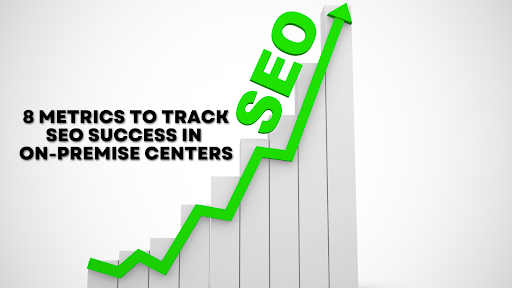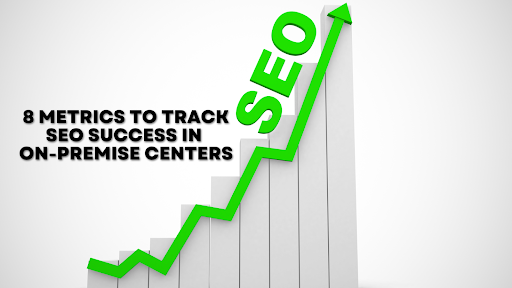Businesses must opt for on-premise solutions when they require greater control, security, and customization over their data and IT infrastructure. On-premise systems allow companies to manage and secure their sensitive information internally, which is critical in industries with stringent compliance requirements, such as finance and healthcare.

Search Engine Optimization (SEO) plays a crucial role in enhancing online visibility and driving targeted traffic to these physical locations.
But how do you measure the effectiveness of your SEO efforts? Let’s explore the key metrics that can help on-premise centers track their SEO success and make data-driven decisions to improve their online presence.
How to Track SEO Success in On-Premise Centers
Tracking SEO success in on-premise centers requires a focused approach to metrics that reflect the unique challenges of locally-hosted environments. Key metrics such as organic traffic growth, keyword rankings, conversion rates, and bounce rates provide critical insights into the effectiveness of SEO strategies.
Additionally, monitoring domain authority and organic visibility helps gauge the overall strength and reach of the website. When comparing on-premise solutions to cloud-based alternatives, it’s essential to understand the differences in SEO tracking capabilities, making the choice between advanced contact center for on-premise solutions a significant factor in achieving optimal SEO performance.
Organic Traffic Growth
Organic traffic growth refers to the increase in the number of visitors to a website who arrive through unpaid search results. Organic traffic is the lifeblood of your online presence. It’s a direct indicator of how well your SEO strategies are performing.
For on-premise solutions, organic traffic growth is crucial as it indicates the effectiveness of SEO efforts in driving relevant, high-quality traffic to the website without relying on paid ads.
To measure organic traffic growth in on-premise environments, tools like Google Analytics can be integrated within the local infrastructure. By setting up tracking for organic search traffic, you can monitor key metrics such as the number of visitors, session duration, and pages per session over time.
Additionally, analyzing trends and comparing them against previous periods helps in understanding the impact of SEO strategies. Regular audits of search performance and keyword rankings are also essential to ensure consistent growth. This data allows organizations to refine their SEO efforts and focus on strategies that deliver the most significant results.
Keyword Rankings
Keyword rankings refer to the position of a website’s pages in search engine results for specific keywords or phrases. Higher keyword rankings are critical as they determine the visibility of your website in search engine results, directly influencing organic traffic.
In on-premise solutions, keyword rankings can be measured using integrated SEO tools such as Ahrefs, SEMrush, or custom analytics solutions hosted within the local infrastructure. These tools track the positions of targeted keywords over time, allowing businesses to assess their SEO performance. For instance, a business specializing in tiny homes for sale would monitor the ranking of this specific keyword to attract more organic traffic. Regular monitoring of keyword rankings helps in adjusting SEO strategies to maintain or improve visibility
Conversion Rates from Organic Traffic
In on-premise solutions, you need to measure the percentage of visitors who complete a desired action (like signing up, making a purchase, or filling out a form) after arriving at a website through organic search results. High conversion rates indicate that the organic traffic is well-targeted and that the website effectively meets user intent.
The conversion rates can be measured using tools like Google Analytics, integrated within the local infrastructure. By tracking organic traffic and setting up goals for specific actions, businesses can calculate the conversion rate as the ratio of conversions to the total organic visits, helping refine SEO strategies to boost performance.
Bounce Rate
Track the percentage of visitors who land on a webpage and leave without interacting further, such as clicking on links, filling out forms, or navigating to other pages. A high bounce rate can indicate that the content is not engaging or that the website is not aligned with user expectations.
Bounce rate can be measured using analytics tools like Google Analytics, which can be deployed within the local infrastructure. By tracking user sessions and analyzing the pages where visitors exit without further interaction, businesses can identify areas for improvement to reduce bounce rates and enhance user engagement.
Backlink Quality and Quantity
Backlinks are a critical off-page SEO factor that signals authority and relevance to search engines. Quality backlinks can significantly boost your rankings and organic visibility. Use tools like Ahrefs or Moz to analyze your backlink profile:
– Total number of backlinks
– Domain Rating (DR) of linking sites
– Toxic backlinks that may harm your SEO
The best practice is to focus on acquiring high-quality backlinks from authoritative sites in your industry or local community.
Page Speed and Core Web Vitals
Google prioritizes user experience, and fast-loading pages are a key factor in SEO rankings. Core Web Vitals provide a detailed assessment of load time, interactivity, and visual stability.
Use Google PageSpeed Insights and Google Search Console to monitor the following:
– Largest Contentful Paint (LCP)
– First Input Delay (FID)
– Cumulative Layout Shift (CLS)
Optimizing for Core Web Vitals can lead to significant improvements in user experience and SEO performance.
Domain Authority and Organic Visibility
Domain authority predicts how well a website will rank in search engine results pages (SERPs). It is calculated based on factors like the quality and quantity of backlinks. **Organic Visibility** refers to how often your website appears in organic search results, influencing the likelihood of attracting organic traffic.
In on-premise solutions, these metrics can be measured using tools like Moz or custom SEO tools integrated within the local environment. Domain Authority is tracked by analyzing backlinks and other SEO factors, while Organic Visibility is measured by monitoring keyword rankings and the frequency of your site appearing in search results. Regular audits help in maintaining and improving these metrics.
User Engagement Metrics
Engagement metrics like average session duration and pages per session help measure the quality of traffic and the effectiveness of your content in retaining visitors. Analyze these metrics in Google Analytics:
– Average session duration
– Pages per session
– Scroll depth
– Click-through rates on internal links
A best practice is to create engaging, valuable content that encourages users to spend more time on your site and explore multiple pages.
Conclusion
Tracking these 8 metrics is crucial for on-premise centers looking to improve their SEO performance and drive more foot traffic to their physical locations. By focusing on organic traffic growth, keyword rankings, conversion rates, and user engagement, you can create a comprehensive SEO strategy that delivers tangible results.
Remember, SEO is an ongoing process. Regularly monitor these metrics, analyze the data, and make informed decisions to continuously improve your online presence. With patience and persistence, you’ll see your on-premise center climb the search rankings and attract more qualified leads.
FAQs
1. How often should I track these SEO metrics?
Track these metrics at least monthly to identify trends and adjust your strategy accordingly. Some metrics, like page speed and keyword rankings, may benefit from more frequent monitoring.
2. What is the most important metric to focus on for on-premise centers?
While all metrics are important, organic traffic growth and conversion rates are particularly crucial as they directly indicate how well your SEO efforts are driving meaningful business outcomes.
3. How can I improve my on-premise center’s domain authority?
Focus on creating high-quality, authoritative content, building reputable backlinks, and ensuring your site’s technical SEO is optimized. Consistency and patience are key, as domain authority typically improves gradually over time.



